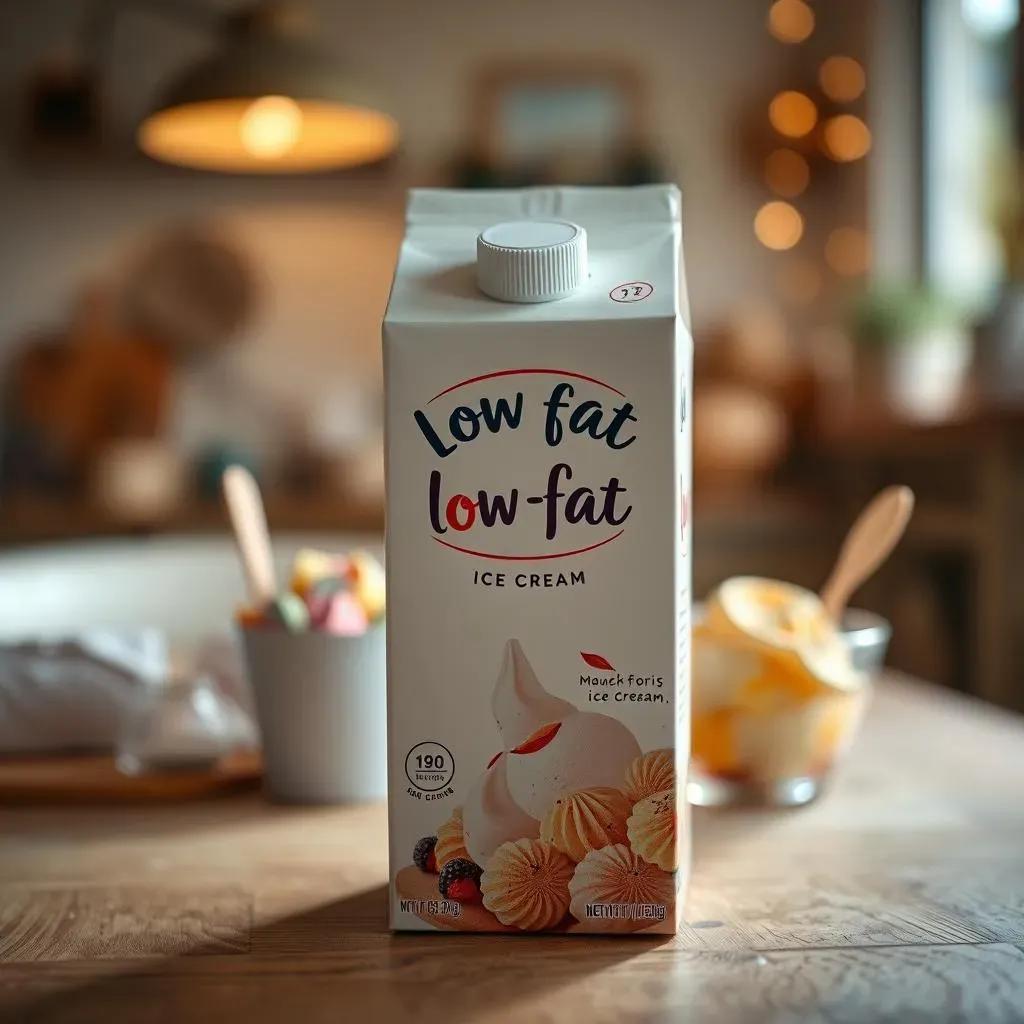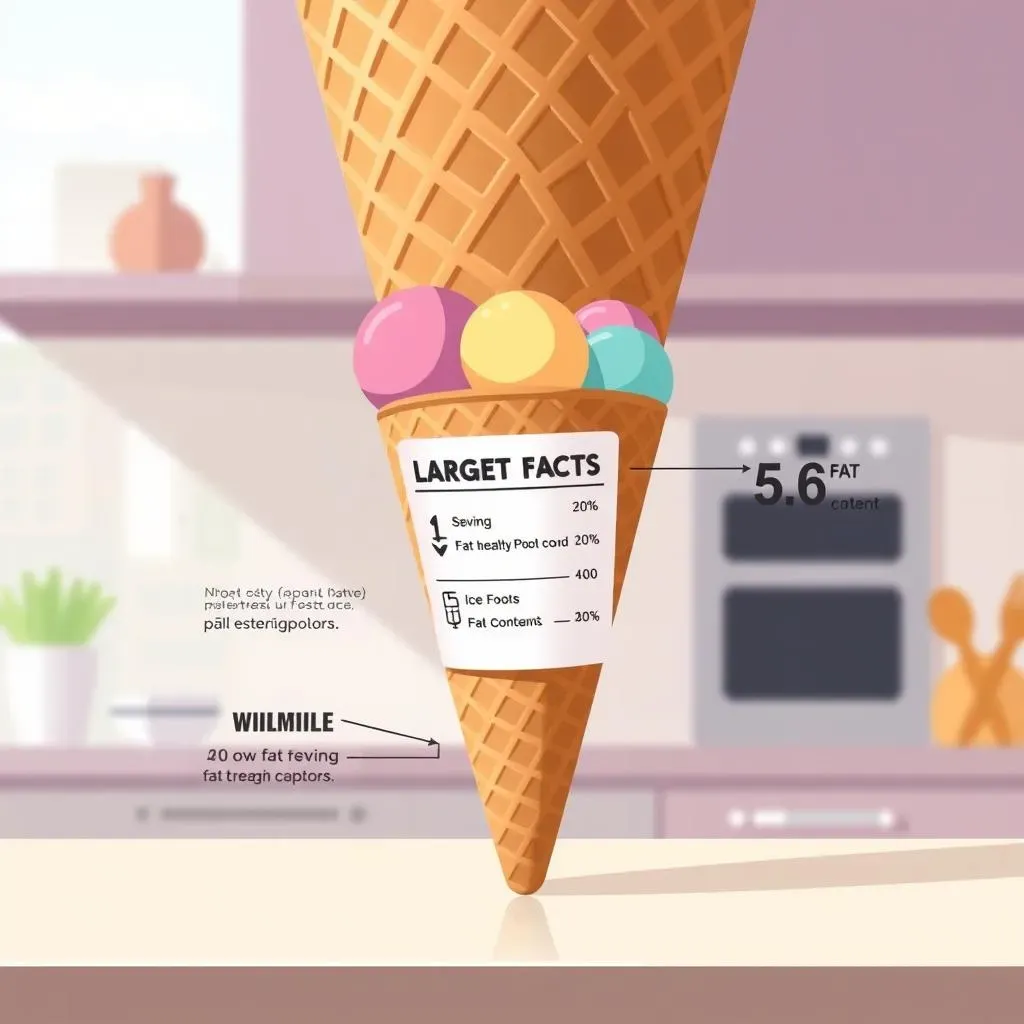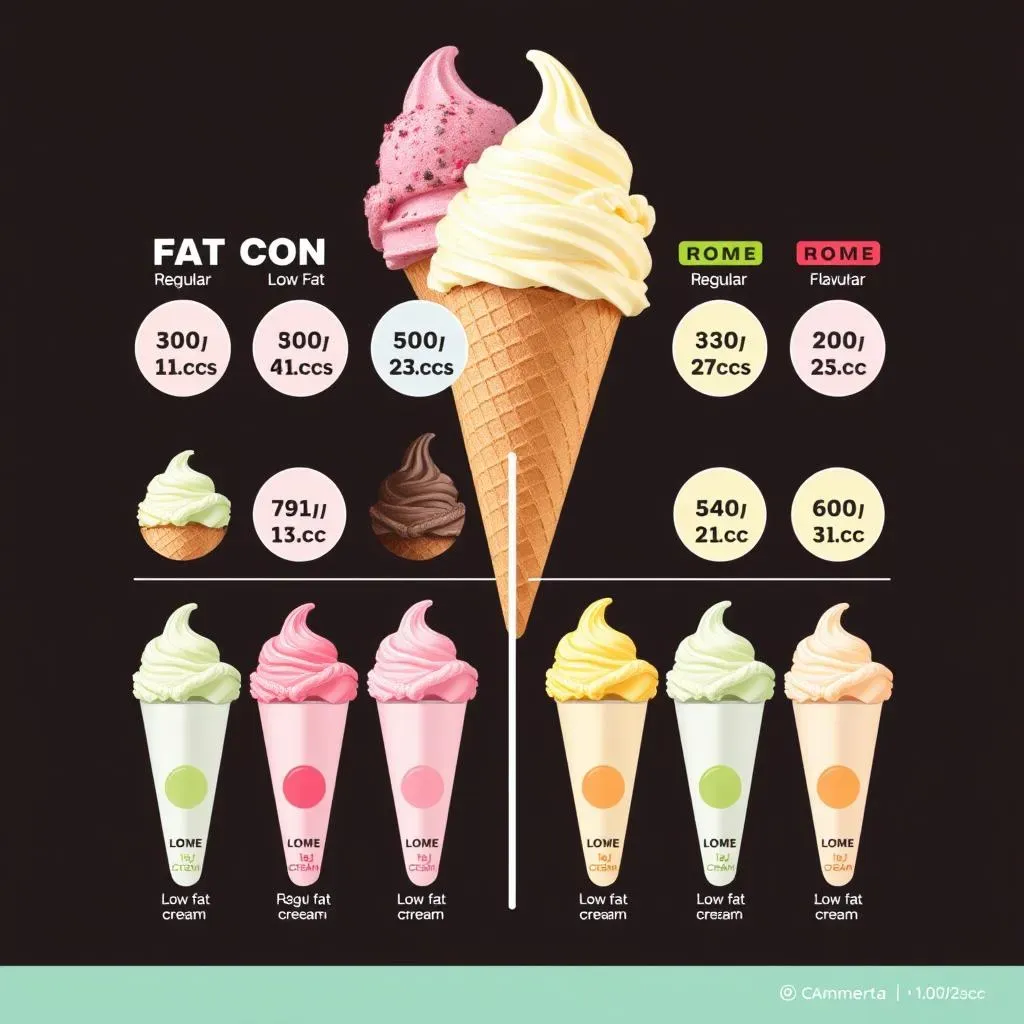Table of Contents
We all scream for ice cream, but what happens when we're trying to be a little healthier? You might reach for that "low-fat" label, thinking it's a guilt-free treat. But have you ever stopped to wonder, how much fat can low-fat ice cream contain? It's not as simple as you might think, and those labels can be a bit sneaky. This article is about to spill the (low-fat) scoop. We're going to break down what "low-fat" actually means in the world of frozen desserts. Get ready to explore the confusing world of ice cream labels, and by the end of this, you'll know exactly how much fat you're scooping into your bowl. We will compare it to the regular ice cream and help you to make a more informed decision about your dessert choices, without sacrificing your enjoyment. So, grab a spoon, and let's get started!
What Exactly is LowFat Ice Cream?

What Exactly is LowFat Ice Cream?
The Skinny on Low-Fat
So, you see "low-fat" on an ice cream carton and think, "Awesome, this is practically a health food!" Not so fast. The term "low-fat" is regulated, but it doesn't mean "fat-free." In the U.S., for a product to be labeled "low-fat," it needs to have 3 grams of fat or less per serving. That's a big difference from the regular stuff, but still something to keep in mind. It's like the difference between a bicycle and a motorcycle, both have wheels, but they're not the same thing, are they?
It's not just about taking the fat out. When manufacturers reduce fat, they often add other things to keep the texture and flavor similar to regular ice cream. Think extra sugar, thickeners, or artificial sweeteners. It's a balancing act, trying to make something taste good without the fat. It's like trying to build a tower with fewer blocks, you might need to use some glue and tape to keep it standing. So, while it might be lower in fat, it's not necessarily a healthier option overall.
What Makes It Different?
Low-fat ice cream usually starts with a base that uses less cream or whole milk, opting for skim milk or a mixture with reduced-fat milk. This is the primary driver for the lower fat content. The goal is to reduce the amount of milk fat, which is where most of the calories and, you guessed it, fat comes from. Think of it like swapping out the heavy cream for a lighter option in your coffee, it still works, but it’s not the same.
But it’s not all about what’s taken out, it’s also about what gets added in. To maintain a smooth, creamy texture, and enjoyable flavor, manufacturers often include additives like gums, stabilizers, and extra sugars. These additives help mimic the mouthfeel and taste that fat provides. It’s like adding extra seasoning to a dish that’s missing a key ingredient. While it might still taste good, it's important to be aware of these changes.
Nutrient | Regular Ice Cream (per 1/2 cup) | Low-Fat Ice Cream (per 1/2 cup) |
|---|---|---|
Fat | Around 7-15 grams | 3 grams or less |
Sugar | Varies, but often high | Varies, often higher to compensate for less fat |
Calories | Around 130-250 | Around 100-150 |
How Much Fat Can LowFat Ice Cream Actually Contain?

How Much Fat Can LowFat Ice Cream Actually Contain?
so we know "low-fat" isn't "no-fat," but just how much fat are we talking about? The official rule, as we mentioned, is 3 grams of fat or less per serving. But here’s the kicker: a serving size isn't always what you think it is. A half-cup serving can look like a tiny scoop, especially if you're used to piling it high. It's like when they say "a handful" of nuts, and your handful is way bigger than the one in the picture. So, while a single serving might be within the 3-gram limit, if you're having a couple of scoops, you're doubling or tripling that fat content. It's a bit of a math game, and those sneaky serving sizes are the wild cards.
Now, let's talk about the numbers on the label. You'll see the total fat listed, and then you'll see the breakdown of saturated and unsaturated fats. The saturated fat is the one you want to keep an eye on, as it’s linked to some health concerns. But, remember, even if the saturated fat is low, the total fat is still there. It's like a car; you can have a fuel-efficient engine, but it still needs fuel to run. So, don't get too caught up in the details and forget the big picture: low-fat ice cream isn't a free pass to eat as much as you want.
Key Things to Check on the Label
- Serving Size: Always check the serving size and compare it to how much you actually eat.
- Total Fat: Look for 3 grams or less per serving to meet the "low-fat" criteria.
- Saturated Fat: Keep an eye on the saturated fat content, as it can impact your health.
- Added Sugars: Low-fat often means more sugar, so check the sugar content as well.
Comparing LowFat to Regular Ice Cream Fat Content

Comparing LowFat to Regular Ice Cream Fat Content
The Fat Showdown
Alright, let's get down to brass tacks. When we talk about regular ice cream, we're talking about a dessert that doesn't hold back on the fat. It’s usually made with a good amount of cream, which is where all that richness and, you guessed it, fat comes from. Think of it like a luxurious, velvety blanket. On average, a half-cup serving of regular ice cream can pack anywhere from 7 to 15 grams of fat. That's a pretty big jump from the 3 grams or less in low-fat versions. It’s like comparing a full-on, butter-soaked croissant to a piece of toast. Both are bread, but one is definitely more indulgent.
The difference doesn't just stop at the total fat, though. Regular ice cream tends to have more saturated fat, which is the kind that you're often told to limit. This is because it comes directly from the dairy. It's like choosing between a steak and a piece of chicken; both have protein, but the fat content is different. So, while you might be cutting down on calories with low-fat ice cream, the difference in fat content is really where you see the biggest change.
Digging Deeper into the Numbers
Let’s really break this down, shall we? Imagine you’re staring at two ice cream tubs side by side. One says “Regular” and the other says “Low-Fat.” The nutrition labels, which are often printed in tiny font, are your secret weapons. The regular ice cream, for example, might boast around 10 grams of total fat per half cup, with maybe 6 or 7 of those grams being saturated. Compare that to low-fat, which is capped at 3 grams total fat per serving, and the difference is clear. It’s like seeing a mountain next to a small hill; one is obviously much bigger. That difference in fat isn't just about calories, it's about how that fat impacts your body.
But here’s something to consider: manufacturers often make up for the lost fat by adding extra sugar or other ingredients. This is where the “healthier” choice gets a little murky. So, while you're cutting back on fat, you might be adding to your sugar intake. It's a bit like trying to fix a leaky faucet and accidentally breaking the pipe – you've solved one problem but created another. Remember, it's about the whole picture, not just one number on a label.
Nutrient | Regular Ice Cream (per 1/2 cup) | Low-Fat Ice Cream (per 1/2 cup) |
|---|---|---|
Total Fat | 7-15 grams | 3 grams or less |
Saturated Fat | 4-10 grams | 1-2 grams |
Sugar | Varies, often high | Varies, often higher |
The Real-World Scoop
so we’ve looked at the numbers and the labels, but how does this play out in real life? Well, think about the last time you had ice cream. Did you really measure out a half-cup serving? Probably not. Most of us, myself included, tend to eyeball it, and we usually end up with more than the recommended amount. This is where those differences in fat really start to add up. If you’re scooping out a generous cup of regular ice cream, you could easily be consuming 20-30 grams of fat, which is quite a bit. It’s like going for a “small” popcorn at the movies and ending up with a bucket that’s bigger than your head. It’s easy to underestimate how much you’re actually eating.
On the other hand, if you choose low-fat, even if you end up with a bit more than a half cup, you’re still likely consuming less fat overall. But, and this is a big but, don’t forget about the sugar. If you're eating low-fat ice cream and you're not really focusing on the rest of your diet, you might not see the results you're hoping for. It's a balancing act, folks. It’s not about demonizing regular ice cream or glorifying low-fat, but about making informed choices and enjoying your treats in moderation. It's like choosing the right tool for the job; you wouldn't use a hammer to paint a wall.
Is LowFat Ice Cream a Healthier Choice?

Is LowFat Ice Cream a Healthier Choice?
The Healthier Halo
so the big question: is low-fat ice cream actually a healthier choice? Well, it's not a simple yes or no. It's more like a "maybe, but it depends." On one hand, you're cutting down on fat, especially the saturated kind, which can be good for your heart. It’s like choosing a smaller slice of pizza, you're still getting the pizza, but you're not overdoing it. But, that's not the whole story. As we’ve discussed, when fat gets reduced, something usually takes its place, and that's often sugar. So, while you might be saving on fat, you could be increasing your sugar intake, which isn't great for your overall health. It's a bit like swapping out your sugary soda for a diet version, you’re reducing the sugar, but you’re getting other artificial things. The key is to look at the whole picture, not just one number on the label.
Also, let’s remember that "healthier" is relative. If you're switching from a full-fat ice cream sundae with all the toppings to a small serving of low-fat ice cream, then yes, that's a step in a healthier direction. But, if you're eating a whole pint of low-fat ice cream, thinking it's a "health food," then you're probably not doing yourself any favors. It's like thinking a salad is healthy even if you drown it in ranch dressing. It’s all about balance and moderation. So, low-fat ice cream can be a good option if you're mindful of portion sizes and the overall nutritional content of your diet. But it's not a magic bullet for health.
The Moderation Mindset
The truth is, no matter which ice cream you choose, it’s still a treat. It's not something you should be eating every single day. It’s like having a piece of cake on your birthday, it’s great in moderation, but not so great if you eat it every day. Instead of focusing on whether low-fat is "healthier," think about it as a way to have a treat without overdoing it on fat. It’s like choosing a smaller portion of fries instead of a large one, it’s still fries, but you're being more mindful. It's about making conscious decisions that fit into a balanced diet and a healthy lifestyle. You should enjoy your food, but also be aware of what you are putting into your body.
Ultimately, the best approach is to enjoy all foods, including ice cream, in moderation. If you like regular ice cream, have a small scoop and savor it. If you prefer low-fat, that's fine too, just be mindful of your portion size and the other ingredients. It's about being an informed consumer and making choices that you feel good about. It's like being a responsible driver; you can enjoy the ride, but you need to follow the rules of the road. So, instead of getting caught up in the "healthier" debate, focus on enjoying your treats responsibly and mindfully. And, hey, if you really want to be healthy, maybe try a fruit smoothie sometimes. Just a thought!
Factor | Low-Fat Ice Cream | Regular Ice Cream |
|---|---|---|
Fat Content | Lower | Higher |
Saturated Fat | Lower | Higher |
Sugar Content | Often Higher | Varies, can be high |
Overall Health | Potentially better for heart health, but not always "healthier" due to added sugars | Can be part of a balanced diet in moderation |
Moderation | Important, as it's still a treat | Important, due to higher fat and calorie content |
The Final Scoop on Low-Fat Ice Cream
So, we've navigated the frosty landscape of low-fat ice cream, and it turns out, the "low-fat" label doesn't mean "no-fat." While it does have less fat than its regular counterpart, it's crucial to check those nutrition labels and see exactly what you're getting. Don't let the marketing fool you! Low-fat options can still pack a punch of sugar and other additives. The key takeaway? Being informed is your best tool. Whether you're aiming for a healthier lifestyle or just trying to satisfy your sweet tooth, understanding how much fat can low-fat ice cream contain empowers you to make better choices. Now go forth, enjoy your ice cream, and maybe consider a brisk walk after.
